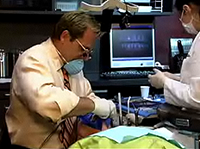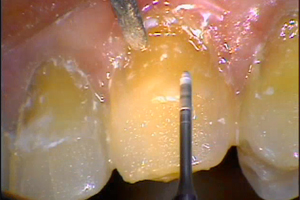Learn From the Dental Industry's TOP LEADERS!

Sit Chairside with
Dr. Dennis Wells
Creator of
DURAthin® Prepless Veneers
- OR -
Larry Rosenthal
Sonia Leziy
Michael Koczarski
Henry Gremillion
JUST TO NAME A FEW!
Register for a PREMIUM membership and learn from the best in the industry!
|
Using Composite Resin in Aesthetic Restorative Dentistry
Part 2 - Preparation
Instructors:
Buddy Mopper, DDS
Buddy Mopper, DDS
Dr. Bud Mopper is an internationally renowned lecturer in esthetic dentistry with an emphasis on composite bonding using direct application techniques. Dr. Mopper is in private practice in Glenview, Illinois, where he has been doing minimally invasive dentistry with composite for 40 years.
Dr. Mopper demonstrates preparation of the teeth
All right, so if you take a look, you can see the preps in the long bevel. And we've shown you where we want the material to go to. I'm gonna add the material to follow the contour of the tooth surface. You're gonna follow the convexity all the way up. But you're gonna blend the material on the tooth surface, past that long bevel, into this area. And then, if I can get this this way, okay? So you can pass the long bevel, and you blend it in onto the tooth surface, and you're never gonna finish back after that bevel. Let me show you what I mean when we start the finishing process. So let's go ahead and answer that. Now, the neat thing about this, is that we do all three of them. We fill all three of them at the same time, essentially. In other words, I'll do one, and contour and shape and form it, and polymerize it, and then I'll, I'll free up the proximal to make sure there's no material that's, that, that's rough. And I smooth the proximal. Then I go to the next one. The reason I do that is because I wanna, I wanna contour these all at the same time. If I were just to contour and finish one, it would start gingival bleeding, and I'd have more trouble to contour, finish, and polish the rest of them. So I do, I restore them all at the same time, and I finish them all at the same time. This works very nicely, and it makes the procedure much more rapid. So now we have a Mylar strip in place. Why am I not putting Mylar on the other side? Because I don't need to. It's because on the other side is a crown that she has on there. And so, you're not gonna, you can't etch that crown, you can't do anything to it, so . . . give me a little more of that. So I just finely etch it with a brush. It gives me complete control. I can etch anywhere I want on it. And I also apply my bonding adhesives with the brush. So we're gonna etch this old tooth, because primarily, she's gonna have the material, past this bevel, and it's gonna, it's not gonna veneer the whole tooth, but it's gonna blend closer to the incisal edge in this particular tooth, than it does down towards the gingival. So we'll just etch the whole tooth. We leave that on for fifteen seconds. My whole premise of etching is to get it on the enamel first, then place it on the dentin. If you leave it on for fifteen seconds, that means everything's finished for about 20, 25 seconds. Now you can see this is the frosty appearance of the tooth surface. I leave the strip in. Can you put another strip in here? The only reason I don't put another strip in on the other side, is to keep the bonding adhesive off the other tooth. It really won't make much of a difference in this particular instance, but we do it anyway. And . . . let me have a little water. Since I'm in the dentin, I use an acetone base. I use a material called Complete, it's a very nice system. I don't, I don't believe you only need one bonding agent in your whole, in your whole array of material. And I know that you're trying to sell a bunch, but I don't care whose system you use, whether it's the system I use or somebody else's system, you need one that bonds to everything. Okay, let me have the primer. So you need one that has a primer in it, one that has an unfilled resin in it, and one that has a dual care catalyst in it. You get a system like that, and you're gonna have a system that you can bond to any material, whether it's acrylic or porcelain or metal or tooth structure, whatever. So what I do . . . let me have it . . . get it over here. I put on three coats real quick. Air dry it. And put on another coat. And I find this, this is virtually, especially in the anterior portions of the mouth, it gives us virtually zero sensitivity. And this is the way we, we've been doing it actually since all the materials came out, basically, the dentin bonding materials. And I don't believe in everything in one bottle, as you can see. So we're going through the steps, it doesn't take you any time anyway. So polymerize that for me please. So that's . . . the tooth is prepared, you're ready to go. The etch is off. The bonding adhesive is on. And we're ready to apply our material. Which is an A3.5, A3 through A3.5, which is an A3.5 microfill, period. Now . . . can you get the flowable? Uh hmm.
Now, we're gonna start with a flowable. 'Cause one of the, one of the things, one of the problems that people have, is that they say, “Well how can I get that material on?” One of the problems is you're sculpting the material on the tooth surface. “When I sculpt it, sculpt the paste material on, it tends to come away.” Well, number one, you should be using titanium coated blades, like the instruments we use, which are the Cosmedent instruments, which are really tremendous. We love them because they come in all, we have the shapes and forms that will get you underneath the free margin, as well as per application. You need an instrumentation system like that. Number two, when you're, when you're sculpting material, you should always be sculpting into the sulcus, when you start with these, you should apply it, sculpt into the sulcus first, not away from the sulcus, that will, that will also help you. But the third thing that really helps me, is I always start with a flowable microfill and underfill it. And it's easier to place composites to composite. So we use a very light coat. If you want to undershow it, we do it very slowly. We don't need a lot. I can come down here where you can see all the margins. I have complete control of this stuff. Because I want to put the paste material over the top of it. This is gonna help the paste material go on rapidly. We polymerize it for about 60, about 40 seconds is all you need on this. Now, once the flowable microfill is in place, we can easily adapt to the composite. I put it in a roll in a convenient form. And I use my fingers all the time, you'll see that. And I'm just gonna apply the material, and I'll put it into place. And I can mold it, I can shape it. Your gloves are clean and dry, and there's no powder on them. Does not contaminate the material. You don't have . . . that is a myth. You can touch this material all you want, nothing's gonna happen. Go ahead.
Now we use light. I'm not a brusher, I'm a sculptor. If you wanna brush you can, I don't. You can see I'm gonna take this past the long bevel, blend it up onto the tooth surface. Everything is done very gently. That's just a little too wet. And you can see how I'm adding this, sculpting it, shaping it. Taking it down, just slightly beneath the free margin. Blending it on the tooth surface. Then using very light touch. You don't need heavy touch. You don't need to compress this material, the material's already compressed. You don't need to do that. So I've got the hands . . . my hands are like the hands of a sculptor. I'm molding. You see how the tooth is . . . can you see that under the camera? 'Cause I'm not looking. Then I switch to a really fine bladed instrument, which is IPC short blade, which is almost like a razor blade. Then you can bring this material into the inner proximal. I'm gonna use this material to close down these margins completely. 'Cause people say, you know, you will get some polymerization shrinkage with the material. So to make sure that I get away from polymerization shrinkage, I've always done this, is that I've always taken another material around any margin, whether it's a gingival margin or whatever it is, inner proximal margin, to close down, make sure I close down those margins. So I'll sculpt against already ready pre-polymerized material. This material actually started to polymerize underneath the light source that they're using for the camera. It's not completely polymerized, but that's okay. It's polymerized enough. Since we're doing them together, okay, we're restoring them all together at the same time, I wanna make sure, that there's no material, that one material doesn't stick together. So what we have to do is make sure the proximal portion of this is nice and smooth. Here we're going in with a FlexiDiamond strip, which is a 15 micron strip. It's a real fine micron strip. Then we follow it with a, give me a, with an aluminum oxide thin one. The reason we're using the narrow strip is 'cause we don't wanna violate the integrity of the gingival margin. We'll go ahead in here. Then we will use the fine, and then follow it up with a superfine. That way, these materials cannot stick together, period, okay?
|

 Submitting...
Submitting...



 FAGD/MAGD Credit Approval does not imply acceptance by a state or provincial board of dentistry or AGD endorsement 7/31/2018 to 7/31/2021 Provider ID# 317928
FAGD/MAGD Credit Approval does not imply acceptance by a state or provincial board of dentistry or AGD endorsement 7/31/2018 to 7/31/2021 Provider ID# 317928